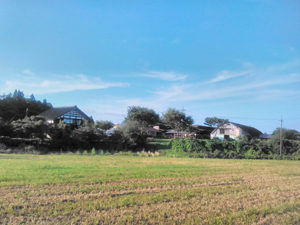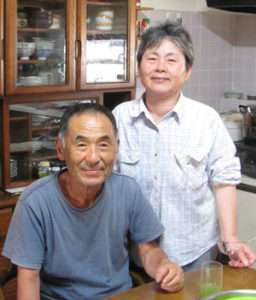Cornucopia’s Take: Our friends at Family Farm Defenders recently visited a family operated dairy farm in Japan. We thought you might enjoy this account of their visit to the Two Little Hills farm.
“Watch out for the cars, Karen! You can’t trust those old folks’ driving!” my host father warned as he shuffled over to pick me up from the bus stop. I had just arrived for what would be a two-week homestay at a small dairy in the Noto Peninsula, off the western coast of Japan. At 73, my host Mr. Hashimoto is no longer a young man himself, but his eyes still have a bright twinkle and he exudes the youthful energy of someone decades younger. This energy keeps the fields plowed and the cows milked at Futagoyama Farm.
 |
Futagoyama, or “Two Little Hills,” consists of nearly 100 acres and approximately 40 milking cows, and has been run by the Hashimoto family since the early 1960s. Most of the work of operating the dairy is done by Mr. and Mrs. Hashimoto, along their 40-year-old son who is single and lives in the family home. However, a couple of part-time staff and frequent WWOOF (World Wide Opportunities in Organic Farming) volunteers like myself often lessen the workload.
Futagoyama Farm is like many dairies across Japan. While Hokkaido, an island north of the mainland, is often thought of as the main producer of all things dairy, many smaller, regional farms scattered across Japan actually provide the country with fluid milk. These family-run operations mainly raise Holstein in confinement and average around 50 cows.1 Milk from these farms is aggregated, marketed, and sold regionally through cooperatives and other nationally designated groups. This centralized system is highly encouraged through government incentives, so only three percent of dairy farmers opt out2.
At Futagoyama, as a WWOOF volunteer, my mornings started at 7:00 a.m. with a quick breakfast of toast, perhaps some yogurt or milk, and a wheat grass juice that Mrs. Hashimoto fed the family. By 7:30, we were out feeding the cows and preparing to milk. After the milking was finished, I’d help with odds and ends around the farm. One day I’d harvest potatoes, the following day I’d weed-whack, and on the third day, perhaps I would clean the tractors or the barn.
 |
Between noon and 2:00 p.m., various members of the family would go inside for a nap and the feast of a lunch that Mrs. Hashimoto would prepare. Lunch and dinner at the Hashimotos’ tended to be relatively traditional: rice, lots of fresh fish—the ocean was just a 15 minute drive away—and nukazuke, a type of quick pickle made by fermenting vegetables overnight in a rice bran culture. After the midday break, the afternoon would pass with more chores, and we’d finish the day around 9pm after the second milking.
Throughout my day, I was often reminded of the connections this farm and the Japanese dairy industry have to the United States. “Start” and “open” were printed on the equipment we used despite the fact that few Japanese know English. These labels struck me as surprising until I remembered how small and new the Japanese dairy industry is compared to its Western counterpart.
Commercial dairies didn’t start appearing in Japan until about a hundred years ago, after Japan had opened its doors to the West. And milk didn’t become common until the 1950s3. After World War II, the United States started supporting war-torn Japan with food aid for school lunches, which consisted of white bread, a hot dish, and milk4. Today, milk and other dairy products are consumed by people of all ages. However, milk is still rarely used in household cooking, and therefore per capita consumption is less than half that of the United States3.
While fluid milk is their main product, Mr. and Mrs. Hashimoto also take great pride in the ice cream that they produced and sold on the farm. “We never use any chemical additives like most of the conventional stuff you buy,” Mr. Hashimoto said. “Most ice cream is just way too sweet—it’s just no good,” Mrs. Hashimoto added. While my favorite flavors were a creamy banana flavored only with bananas and “sea salt,” which featured salt harvested from across the peninsula, Futagoyama’s bestseller was its simple “milk” flavor.
Simplicity and purity weren’t the only keys to Futagoyama ice cream. As I learned soon after I arrived, the Hashimotos put great care into providing their cows with clean water and quality feed. When the family welcomed me into their home on my first day, Mrs. Hashimoto offered me a cup of water, not tea, the typical beverage in Japanese households. “We use our own pure well water. Isn’t it delicious?” she asked. After lunch that day, Mr. Hashimoto pulled out several files, showing me the extensive tests he’d had done on his soil and feed. Several years ago, he “made a big mistake,” he explained. His cows were becoming sick and he couldn’t figure out why. Finally, he traced the problem back through the food chain to the soil in his fields. Too much compost. The potassium levels were soaring.
Over fertilization isn’t the only challenge Futagoyama Farm has faced. Like most dairy farmers in Japan, the Hashimotos also import hay from the United States to supplement what is grown on site. According to tests from local prefectural labs, American feed has extremely high levels of nitrogen that seem to slip through regulations in the US. “This is poison!” my host father exclaimed, emphasizing his point by talking in English. “And everyone is using it. They just don’t know how bad it is.”
Since these discoveries, Mr. Hashimoto has been refining his hay cultivation techniques. “My milk and ice cream is delicious because my cows get delicious feed,” he’d occasionally remark. Using the compost made from his manure, along with a deep tilling technique, Mr. Hashimoto works endlessly to make the perfect soil conditions for growing hay. He harvests hay three times during the summer, storing it up for much of the year. After the last hay harvest in July, he plants cover crops of clover and other legumes.
Despite his skepticism of American-grown grain, Mr. Hashimoto remains fascinated by America, particularly the dairy and cattle industry. Several times during my stay, he asked me incredulously about the low milk prices in US. In Japan, milk sells for about 200 yen per liter (about 2 dollars per quart), and farmers receive about half the market price. “How do farmers in American do it?” he’d often wonder. Mr. Hashimoto has been to the US, to Wisconsin in fact, on a tour with other Japanese dairy farmers. During most of our trips to town, he’d put on a souvenir from his time abroad: a wide leather belt with a large flashy buckle. Once, he even pulled out a leather coat and a cowboy hat he’d picked up from his travels.
While it would be difficult to mistake Mr. Hashimoto for your typical American dairy owner, he and his farm face a challenge similar to that of many farmers in the US—he and his wife have no clear successors for their dairy. For without a family to help him, it will be difficult for their single son to carry on the business. Throughout Japan, dairies are decreasing in number as aging farmers retire and increasing in size. As of 2015, the number of dairies in Japan had dropped by 15 percent in just four years to 17,000 farms1. Ishikawa Prefecture, where the Futagoyama is located, is no different. As Mr. Hashimoto lamented one day as I was enjoying some of his ice cream, “Once I’m gone, this delicious ice cream will be no more.”
Karen Weldon currently lives in Ishikawa, Japan, where she teaches English while studying and participating in rural Japanese life. Karen graduated from Macalester College in St. Paul Minnesota in 2014. As a student studying Food Systems and organizing around food and agricultural issues, Karen connected with the Family Farm Defenders during a farm work weekend organized by Anthony Pahnke, FFD board member.
1. Obara, Kakuyu. “Japan Dairy Products Annual: 2016 Outlook and 2015 Situation Summary.” Global Agricultural Information Network. USDA Foreign Agricultural Service, October 15, 2015. http://www.card.iastate.edu/products/publications/pdf/05wp401.pdf.
2. Masanori, Kikuchi. “Why Does Japan Have Butter Shortages?” Nippon.Com, October 19, 2015. http://www.nippon.com/en/column/g00316/.
3. Campo, Isabelle Schluep, and John C. Beghin. “Dairy Food Consumption, Production, and Policy in Japan.” Center for Agricultural and Rural Development – Iowa State University, August 2005. http://www.card.iastate.edu/products/publications/synopsis/?p=785.
4. Eplett, Layla. “How the Japanese Diet Became the Japanese Diet.” Scientific American Blog Network, March 3, 2016. https://blogs.scientificamerican.com/food-matters/how-the-japanese-diet-became-the-japanese-diet/.
5. Centre, Government of Canada; Canadian Dairy Information. “Per Capita Global Consumption of Fluid Milk.” Canadian Dairy Information Centre (CDIC), December 8, 2015. http://www.dairyinfo.gc.ca/index_e.php?s1=dff-fcil&s2=cons&s3=consglo&s4=tm-lt.
6. “Japan Dairy Farming.” Japan Dairy Council. Accessed July 31, 2017. http://www.dairy.co.jp/dairyeng.html.

